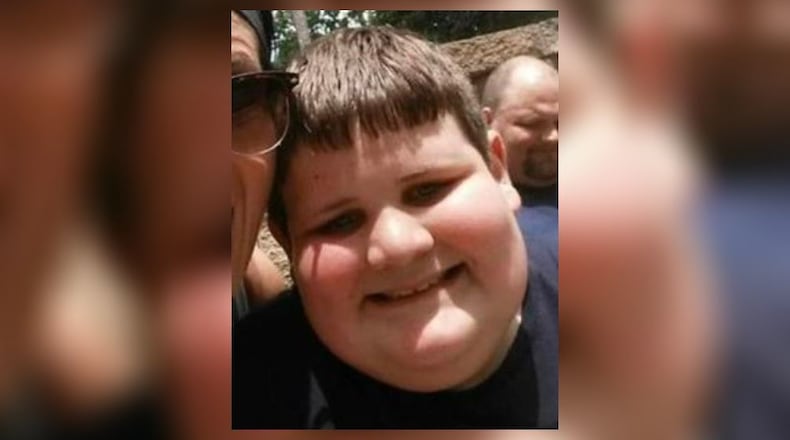As pediatric cases of COVID-19 started spiking across Georgia last month, 13-year-old Porter Helms was among those who tested positive. The eighth grader had been quarantining at home in Floyd County for about a week when his father checked on him and gave him medications at 3 a.m. Tuesday.
When his dad came back two hours later, Porter wasn’t breathing. Emergency workers tried CPR and transported him to the hospital, but he could not be revived, according to Floyd County Coroner Gene Proctor
Cause of death, the coroner determined, was respiratory failure due to COVID-19. “That’s the first juvenile (in Floyd County) that we can actually say that died of the COVID-19 virus,” Proctor said, adding that he did not know the child’s vaccination status.
Porter’s school, where masks were recently required, said it was heartbroken that the pandemic had claimed a child’s life.
During previous surges of COVID-19 in Georgia, children and teens were largely spared from serious illness, and child deaths were extremely rare. Of the more than 19,000 confirmed COVID-19 deaths, there have been 17 reported deaths of children.
But at least four of those children, including Porter, died as the highly contagious delta variant has become pervasive in the state. Earlier in August, a 17-year-old Douglas County boy died after contracting the coronavirus; in July, a 5-year-old Gordon County boy died; and in June a 14-year-old Clayton County boy died.
Confirmed COVID-19 cases among children are now at their highest point of the pandemic, and delta is pushing record numbers of the young Georgians into pediatricians’ offices, emergency departments and even hospital beds.
Georgia ranked third nationally, behind Florida and Texas, for pediatric COVID-19 hospital admissions during a seven-day period ending Aug. 29, according to a federal report. While state public health officials say pediatric hospitalizations for COVID-19 are still rare, they doubled during the most recent two-week period.
Federal and state counts of children hospitalized with COVID-19 vary. The state Department of Public Health said 69 children were hospitalized with COVID-19 during the week ending Aug. 29. but, a federal report showed 267 pediatric hospital admissions for the seven-day period that ended Aug. 29.
COVID-19 cases made up nearly 14% of recent emergency room visits in Georgia for children between ages 12 and 18, and more than 10% of visits for kids between 5 and 11, according to state public health officials.
Hospitals are struggling with the surge.
“Our Emergency Department is being inundated with suspected and confirmed COVID cases,” said Dr. Jacob A. Eichenberger, a pediatrician at The Children’s Hospital of Georgia in Augusta, which is part of the Augusta University Health System. Several times in recent weeks the hospital has put a hold on transfers from other hospitals because it was so busy.
Some children come in with vomiting and dehydration caused by COVID and need IV fluids, he said. Some infants who get COVID infections from their mothers can develop high fevers and have to go through testing to rule out other possible causes.
A small number of the hospital’s COVID patients are critically ill in the pediatric ICU, with some needing care on ventilators or high-flow oxygen, Eichenberger said.
The pediatrics hospital is even seeing how children are being affected by serious COVID-19 illness among adults. “We have had children ready for discharge, but both or their only parent is in the hospital sick with COVID as well, so there isn’t a place for the child to go yet,” he said.
Eichenberger, who is an assistant professor at The Medical College of Georgia, said he’s also concerned about the long-term health consequences many children with COVID-19 may face.
Children’s Healthcare of Atlanta on Tuesday said its hospitals were caring for 34 patients with active COVID-19 cases and 25 more patients continuing to receive care for COVID-19 related conditions. CHOA also said its emergency departments were dealing with “extremely high volumes” due to COVID-19 and other respiratory viruses.
Pediatric hospitalizations still make up just a small portion of all the hospital cases statewide. As of Wednesday, hospitals across the state reported caring for 5,729 COVID-19 patients of all ages, a patient load that exceeds the previous pandemic peak in January that sent the state’s hospitals into crisis. A third of Georgia’s hospital beds are taken up with patients sickened by COVID-19. Every hospital in Georgia is now full or overflowing.
The surge driven by the delta variant is coinciding with the return to in-person school in Georgia. For the week ending Aug. 27, the overall COVID-19 case total in 14 Atlanta-area school districts neared 7,000.
Pediatricians stress that children ages 12 and up can be protected by getting vaccinated. But among children 12-17 who could get the shot, only one in four is fully vaccinated, according to federal statistics. Children younger 12 aren’t eligible to be vaccinated.
Dr. Samira Brown, a primary care pediatrician at Piedmont Health Care at Covington, said a lot of her work is educating families who are now being touched by the pandemic. ”In our practice, we definitely are feeling the surge on a daily basis,” she said. “We have countless calls. We have an increased number of positive tests in our office. And, of course, then the stress of families.”
Brown said the practice is making changes to bring in as many patients as possible for both testing and treatment.
“Most kids who have COVID are going to get better with just symptomatic care at home,” she said. “But we always want our parents and our caretakers to know what kind of complications come up and what to look for, when to call us back, and when to come in.”
The Latest
Featured





